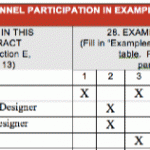
There is a sermon that far too many people in this industry preach. I hear it all the time from experienced “marketing experts.” Over and over again they say, “don’t submit a proposal unless you have a relationship.” “Don’t waste your time and money subscribing to lead services, you won’t get anywhere without relationships.”
If you consider the various types of firms in the A/E/C industry, this is not good advice. What these people are saying does not apply to all businesses. Say for example, you are a contractor who does low bid work. That’s a case where it might be foolish not to respond because you don’t have a relationship. Here’s another example, let’s say you are a design firm that designs BSL-4 labs. There are not that many firms that have extensive experience designing those. And while the owner might prefer choosing someone they have a “relationship” with, my sense is that they would much rather keep that Ebola virus from escaping and killing us all. So in that case, qualifications matter.
I imagine the same would apply for nuclear power plants. We may see billions in construction of new plants. But my gut tells me that there are very few people left in our industry who have ever designed one. Now I love my drinking buddies, but I wouldn’t hire them to design my nuclear power plant.
“Relationships” Don’t Win You Work
“Relationships” are certainly a factor in the decision making process. But unfortunately, you are not getting the whole story about relationships. It’s not really a relationship, per say, that influences decisions. You have to break the concept of relationships down to the molecular level and gain a better understanding of what exactly is it about relationships that influence decisions. I don’t see this being done with the topic of relationships.
For example, it is true that “studies show that people hire those they like.” But these studies talk about the scientific term “liking.” Liking is why Regis Philbin is the spokesperson for my bank and my hospital. Science shows that because I like Regis Philbin, I am more likely to give them my cash and/or blood. My personal feelings toward Regis are transferred to their product even though I have never met him and could not claim any type of relationship.
Liking is the reason one of my teachers very inappropriately told the dumb girl in my high school to “wear something slutty” to her college entrance interview. She did and she got in because of the “liking effect” and its ability to influence decisions. Liking is something that has been studied extensively and there is a lot more to it than you might realize.
Liking is Weak Compared to Giving
But liking is not the most powerful influence factor in the category of relationships. Reciprocation has been proven in studies to be much more powerful. The rule of reciprocation is that, as humans, we do not like to feel indebted to anyone. When we do, we try to find ways to escape that feeling. We do this by reciprocating (i.e. giving back to those who give to us). . The way you get someone to reciprocate is to give them something of value. This can be good customer service, a hug, a personal favor, a job, or maybe even a relevant lead you saw in one of your lead services. The amount of giving you will have to do for each person will vary. Each person has a different set of values.
Tim Klabunde, of William H. Gordon Associates, Inc., says to “help everybody everyday.” Scientifically speaking, when it comes to “relationship-based” marketing, that’s the best advice you will ever hear.
Liking and reciprocation are not the only factors. Other forces that influence people include social proof, scarcity, commitment/consistency, and authority. There are so many factors that it is very hard to determine how much a “relationship” will factor into any decisions. There can be 10 other people who have better “relationships” than you. A better relationship, when it comes to influencing decisions, is one based on giving.
The Math is Wrong
People also cite how other firms have only submitted on opportunities where they had an ongoing relationship and increased their proposal win percentage. The problem with this thinking is that proposal win percentage, by itself, is not necessarily a great measurement tool. Your goal is probably revenue, not proposal wins. So if you win 50% of $100,000 is it better than 30% of $250,000? I’d rather take the 30%.
So finding opportunities and making go/no go decision should take into consideration various factors, just like the SMPS Marketing Handbook says. We’ve somehow drifted away from those best practices. I strongly agree that you can’t go after everything. But I think the question is, “based on everything we know, do we have a reasonable shot?”
Matt Handal is responsible for marketing at Trauner Consulting Services, Inc., a national schedule and claim analysis firm based in Philadelphia, PA. His experience includes over 10 years of marketing and related activities. He has successfully marketed real estate, architectural, engineering, and construction consulting services, helping firms realize tens of millions in fees from projects ranging from $500K to $2B.
He developed the industry’s first video podcast, Construction Netcast, which teaches professionals in the construction industry how to successfully manage and administer construction projects. He also hosts HelpEverybodyEveryday.com, an open forum and education portal for marketers and business developers. Furthermore, Matt serves as Contributing Editor to SMPS Marketer magazine and is a co-author of the Marketing Handbook for the Design and Construction Industry. He is also an obsessive music fan and avid runner.
This article was originally published in the October 2008 issue of SMPS Marketer. Its republished with permission of SMPS Marketer. Learn more about the Society of Marketing Professional Services and SMPS Marketer at http://www.smps.org





Speak Your Mind